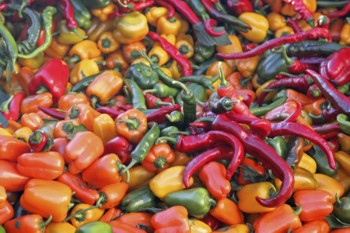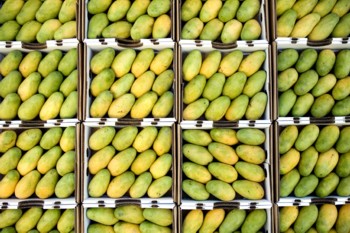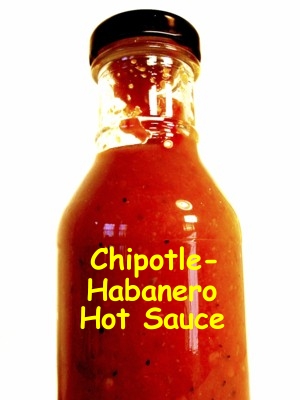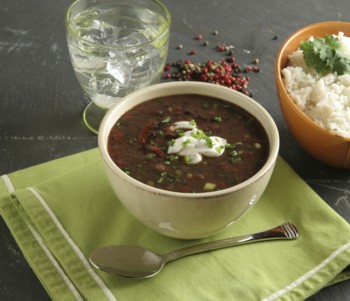 |
Recipes:Chipotle-Habanero Hot Sauce
|
In Miami, heat is as much a part of the culture as bikinis and mojitos. Heat affects everything from the clothes people wear (or don’t wear), to the cars they drive, to the music pumping out of their stereos. In a city like this, it is no surprise that the food reflects this obsession with all things hot and spicy.

Miami is a melting pot, and a majority of the people traces their roots to countries where chiles and fiery foods are king. To see the intersection of caliente culture, the first place you should visit is Little Havana. The heart of this community beats along the famed Calle Ocho, or SW 8th Street. Starting at the south end of Calle Ocho around the intersection of SW 12th (yes, 12th can intersect 8th in Miami), you will pass cigar shops, a record store and a costume shop, but food is the real focus here. At El Siglo Supermarket, you can get a taste of inspiration and shop for Latin ingredients. Even on a quiet Sunday when many shops are closed, El Siglo is jammed with people having lunch at the long wooden counter on one side of the store.
Little Havana is also called the Latin Quarter, and it is easy to see why a more inclusive name was chosen. From the little grocers to the storefront takeout shops, countries all over Central and South America are represented, including Columbia, Nicaragua and Ecuador. The country of Uruguay is depicted in bright orange on the side of one building next to a huge brick oven. A large mural on SW 14th Street of political leaders and entertainers from various Latin countries illustrates the comfortable mix of cultures. To taste a sampling of Miami’s favorite Latin dishes like Ceviche, Cuban sandwiches, Arroz con Pollo (grilled chicken with yellow rice) and Empanadas, grab a shady sidewalk table at El Christo where they serve up these and other greatest hits.
If you are strictly in search of Cuban culture, then head straight for the Domino Club. On Sunday afternoon, players are out in full force at Maximo Gomez Domino Park where tables have been constructed under a large gazebo specifically for the game. It can’t be a coincidence that El Pub, a restaurant with a walk-up window serving strong, sweet Cuban coffee is just up the street.
Miami may be celebrated for Latin food, but it is also one of the few places in America where you can find a large concentration of Caribbean cuisine. Little Haiti is a good place to begin. Adjacent to the lively design district and the newly fashionable Upper East Side, Little Haiti is in the middle of the action. Though this neighborhood has suffered more wear and tear than the Latin Quarter, there are many small businesses along NE 2nd street, including grocery stores, restaurants and the occasional rumored voodoo shop.

Beef patties, the empanada-like pastries stuffed with curried meat can be found here, as they are a favorite in Haitian and Jamaican kitchens alike. Griot, the Haitian specialty of fried pork, is advertised proudly at Chez Le Bebe on NE 54th Street. Haitian stews are mainstays too, especially Callaloo, the concoction of taro, a leafy root vegetable, okra, crab and coconut milk. Legume is a typical home-style beef stew that is easy to make and loaded with a garden full of vegetables.
Jamaica is certainly represented in Miami, so do not pass up the opportunity to try a plate of Jerk Chicken. The dish they serve at Cliff’s, a roadside shack in North Miami, is miles away from the grilled breast of chicken coated with dry spices that is more commonly served. Here, you will get a huge smoked chicken leg, cut into pieces and served with a side of Cliff’s homemade jerk sauce, a dark liquid with hints of chile and allspice.
My favorite Caribbean cuisine comes from the island of Trinidad, where the influence of India is prevalent in the food. L.C.’s Roti Shop is a hidden gem tucked away in a strip mall among other Caribbean restaurants and businesses. Roti is a thin, tortilla-like flatbread cooked on a hot griddle. At L.C.’s, you can grab a stool at the long counter and watch the cooks stretch the smooth dough into a huge circle and toss it on the griddle. They use a long spoon to whack the dough as it puffs up during cooking. When the roti is just slightly blistered, it is filled with a mash of curried potatoes and vegetables and your choice of stuffing. Then it is folded up into a neat package and placed in front of you. The stewed chicken roti is rich and tasty, but watch out for bones, and be sure to ask for it extra spicy if you want a real hit of island heat.
While I will leave the roti making to L.C., I have come up with a few recipes that reflect the people and flavors of Miami. I hope you will visit one day to bask in the Florida sun and sample the fiery food. In the meantime, try the following Miami-inspired recipes.
Miami’s Best Spicy Spots
El Siglo- 1305 SW 8th Street, Miami, FL, 305-854-1916
El Christo- 1543 SW 8th St, Miami, FL 33135, 305-643-9992
El Pub- 1548 SW 8th St, Miami, FL 33135, 305-642-9942
Cliff’s Restaurant- 10740 NW 7th Ave., North Miami, 33161, 305-754-2679
L.C.’s Roti Shop- 19505 NW 2nd Ave., Miami Gardens, 33169, 305-651-8924

3 dried chipotle peppers
1 tablespoon canola oil
1 medium onion, chopped
Salt and pepper, to taste
1 tablespoon mustard seeds, ground in a mortar or spice grinder (or 1 tablespoon mustard powder)
1/2 inch piece ginger, peeled and chopped
1 clove garlic, chopped
1/4 cup pineapple juice
3 habanero chiles, chopped
1 tablespoon Worcestershire sauce
1 teaspoon tomato paste
1 tablespoon blackstrap molasses
2 tablespoons white vinegar
1 teaspoon red curry powder
1/2 teaspoon chile powder
Soak the dried chipotle peppers in warm water for 1 hour. Drain the chipotles, reserving the soaking water, and finely chop.
Heat the oil in a small saucepan over medium heat. Add the onion, season with salt and pepper and cook until lightly browned, 3 to 4 minutes. Add the ground mustard seeds and chopped chipotles and cook for 2 minutes. Add the ginger and garlic and cook for 1 minute more. Add the remaining ingredients, bring the contents to a simmer and cook, stirring occasionally, for 15 minutes. Remove the saucepan from the heat.
If you have an immersion blender, put it directly into the saucepan and run it until you reach the desired consistency. If you want a thinner sauce, add small amounts of the reserved chipotle soaking water.
If you are using a regular blender, be sure to leave the air hole open so steam can escape. Hold a dish towel loosely over the hole while blending. Puree to the desired consistency. The sauce will keep in the refrigerator for up to one week.
Yield: About 1 cup
Heat Level: Very Hot
Sweet n’ Spicy Caribbean Hot Sauce
This sauce is wonderful on grilled chicken and firm fish like salmon. Use it as they would in Trinidad to spice up a fried shark sandwich. If you are using whole spices, grind them in a mortar or in a spice grinder. Allspice berries can be found in Latin and Caribbean markets, as well as specialty food stores. Note: this recipe requires advance preparation.
3 dried chipotle peppers
3 dried allspice berries, ground (or 1/2 teaspoon ground allspice)
1 tablespoon mustard seeds, ground (or 1 tablespoon mustard powder)
1 clove, ground (or a pinch of ground clove)
1 teaspoon turmeric
1/2 teaspoon red curry powder
1 teaspoon ground black pepper
1 tablespoon canola oil
2 cloves garlic, minced
1 shallot, chopped
1/2 inch piece ginger, peeled and chopped
5 habaneros, finely chopped
1/2 mango, chopped
2 tablespoons white vinegar
3 tablespoons light brown sugar
1 tablespoon blackstrap molasses
1/4 cup pineapple juice
Salt to taste
Soak the dried chipotles in warm water for 1 hour. Drain the chipotles, reserving the soaking water. Remove the seeds, finely chop the chiles and set aside. Combine the allspice, mustard seeds, clove, turmeric, curry powder and black pepper in a small bowl and set it aside.
In a medium saucepan, heat the canola oil over medium heat. Add the garlic, shallot, ginger, chopped chipotles and spices. Cook, stirring constantly, for 1 to 2 minutes. Add the remaining ingredients and stir to combine them. Bring the sauce to a simmer and cook for 15 minutes, stirring occasionally.
Check the consistency. If you want a thinner sauce, add more pineapple juice or the chipotle soaking water. Remove the pan from the heat. If you have an immersion blender, put it directly into the saucepan and blend. I like a chunky texture for this sauce. If you are using a regular blender, be sure to leave the air hole open so steam can escape. Hold a dish towel loosely over the hole and blend to the desired consistency.
Transfer the sauce to a jar and store in the refrigerator for up to one week.
Yield: About 1 cup
Heat Level: Hot
Miami Ceviche

Ceviche is made all over Central and South America, so it is no surprise that it has become popular in many Miami restaurants. The citrus marinade creates an opaque color and firm texture that mimics the effect of traditional cooking. In celebration of Miami chefs’ tendency to borrow from many different sources to create a their own recipes, I have come up with a version using the Peruvian garnish of sweet potatoes, the Ecuadorian addition of roasted corn and a combination of seafood that you are likely to find at a typical Miami table. For a glamorous touch, serve the Ceviche in martini glasses. Note: this recipe requires advance preparation.
1/3 pound shrimp, peeled, deveined and cut into 1/2 inch pieces
1/3 pound sea scallops, thinly sliced crosswise
1/3 pound tilapia or snapper fillet, cut into 1/2 inch pieces
1/4 of a small red onion, sliced as thinly as possible into half moons
1 jalapeño, halved lengthwise, seeded and very thinly sliced
Juice of 3 to 5 limes
Juice of 1 lemon
Freshly ground black pepper to taste
1/2 cup sweet potato, cut into 1/2 inch pieces and boiled until just tender
1/3 cup corn nuts
Fresh cilantro, for garnish
Place the seafood, red onion and jalapeño in a medium bowl. Add the citrus juice, using additional lime juice to just cover the seafood, if needed. Add the pepper and gently toss the seafood mixture. Cover with plastic wrap and refrigerate for two and a half to three hours, or until the seafood is opaque and firm. Stir the mixture once or twice during marinating.
To serve, stir the sweet potatoes into the Ceviche mixture and spoon it into four martini glasses. Sprinkle with corn nuts and cilantro and serve.
Yield: 4 servings
Heat Level: Mild
Smoky Black Beans

14 ounces dried black beans, rinsed, picked over, soaked overnight and drained
1 tablespoon canola oil
5 strips center cut bacon, cut into 1/2 inch pieces
1 medium white onion, chopped
3 cloves garlic, minced
1 inch knob of ginger, peeled and cut in half
2 dried bay leaves
2 ham hocks
Salt and pepper to taste
Sour cream, hot sauce, fresh cilantro and chopped scallions, for serving (optional)
Remove the ginger, ham hocks and bay leaves from the pan. Stir the bacon pieces into the beans and season with salt and pepper to taste. Serve, passing the sour cream, hot sauce, cilantro and scallions for guests to garnish as they like.
Yield: 6 servings
Heat Level: Mild
Haitian Legume
“Legume” may be the general term for beans, but this stew is a hearty mix of marinated beef and vegetables. All the ingredients can be found at any supermarket, but the combination of habanero chiles, thyme and allspice gives this dish the exotic flavor of the Caribbean. Serve it over mounds of rice or with hunks of crusty bread to mop up the spiced broth. Note: this recipe requires advance preparation.
For the Marinade:
1/4 cup chopped parsley
2 garlic cloves, minced
1 habanero chile, finely chopped
2 tablespoons white vinegar
2 tablespoons canola or olive oil
Freshly ground pepper, to taste
1 pound beef stew meat, cut into bite-size pieces
For the Stew:
3 tablespoons canola or olive oil, divided
Salt and pepper to taste
1/2 onion, chopped
1 to 2 habanero chiles, finely chopped
2 cloves garlic, minced
3 tablespoons tomato paste
4 cups low sodium chicken broth (canned or made from bouillon)
1/4 teaspoon dried thyme
1/4 teaspoon ground allspice
3 to 4 carrots, cut into bite-sized pieces
1/2 head of cabbage, cored and shredded
1 1/2 cups frozen, shelled lima beans
2 cups frozen French cut string beans
Chopped parsley for garnish
Marinate the meat: Combine the parsley, garlic, habanero, vinegar, oil, pepper and beef in a large bowl. Toss well, cover and refrigerate for 2 to 4 hours. Remove the meat from the refrigerator and bring to room temperature 20 to 30 minutes before cooking.
Make the stew: Heat 1 tablespoon of the oil in a large saucepan or Dutch oven over high heat. Add half of the beef to the pan, season with salt and cook, turning once or twice, until lightly browned, about 4 minutes. Remove beef and any juices to a plate. Repeat with 1 more tablespoon of oil and the rest of the beef. Add the browned beef and juices to the plate and set aside.
Add the remaining oil to the pan and adjust the heat to medium-high. Add the onion and habanero, season with salt and pepper and cook until soft and lightly browned. Add the garlic and tomato paste and cook for one minute, stirring constantly. Add the chicken broth and return the beef to the pan. Add the thyme and allspice and bring the stew to a boil. Immediately reduce heat to maintain a simmer, cover and cook for 45 minutes, stirring occasionally.
Add the carrots to the stew, replace the lid and continue to simmer for 20 minutes. Add the cabbage, lima beans and string beans. Cover and continue cooking for 25 minutes more. Taste for seasoning and add additional salt and pepper, as needed. Ladle into four bowls, sprinkle with parsley and serve.
Yield: 4 servings
Heat Level: Mild




